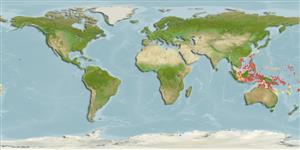>
Gobiiformes (Gobies) >
Gobiidae (Gobies) > Gobiinae
Etymology: Eviota: No etymology given, suggested by Christopher Scharpt: from Latin 'eu' for 'true' and 'iota' for anything very small, in combination 'truly very small' referring to it as being the smallest vertebrate at the time it has benn described by Jenkins (thus, making the suggestion by Scharpt plausible.
More on authors: Greenfield & Randall.
Environment: milieu / climate zone / depth range / distribution range
Écologie
marin récifal; profondeur 2 - 31 m (Ref. 90102). Tropical
Western Pacific: restricted Fiji; distribution in question until further studies within the E. nigriventris complex (which this species is part of) are completed.
Taille / Poids / Âge
Maturity: Lm ? range ? - ? cm
Max length : 1.3 cm SL mâle / non sexé; (Ref. 87726)
Description synthétique
Clés d'identification | Morphologie | Morphométrie
Épines dorsales (Total) : 7; Rayons mous dorsaux (Total) : 9 - 10; Épines anales: 1; Rayons mous anaux: 8 - 9. This species is distinguished from its congeners by the following characters: dark band on entire lower body from the head back to the caudal-fin base where it intensifies and ends in a semi-circle; pectoral-fin base with small black dots, more intense dorsally; cephalic sensory pore system lacking the PITO and IT pores and the AITO pore enlarged; dorsal/anal fin-ray formula usually 9/8; pectoral-fin rays simple; spinous dorsal elongate or filamentous in both sexes; genital papilla nonfimbriate; in life dorsal half of body yellowish cream in color, ventral half dark gray to black in type material, varying to dark reddish in others (Ref. 87726); characterized further by longitudinal scale series 23-24; ctenoid scales except cycloid on breast, none on head, nape and pectoral fin base; separated pelvic fins, bases joins by thin membrane; well developed fifth pelvic ray; depth of body 3.5-5.1 in SL (Ref. 90102).
Forms groups among branches of Acropora coral, inhabits in sheltered reefs in 2-31 m (Ref 90102).
Life cycle and mating behavior
Maturité | Reproduction | Frai | Œufs | Fécondité | Larves
Greenfield, D.W. and J.E. Randall, 2011. Two new Indo-Pacific species in the Eviota nigriventris complex (Teleostei: Gobiidae). Zootaxa 2997:54-66. (Ref. 87726)
Statut dans la liste rouge de l'IUCN (Ref. 130435: Version 2024-2)
Menace pour l'homme
Harmless
Utilisations par l'homme
Outils
Articles particuliers
Télécharger en XML
Sources Internet
Estimates based on models
Preferred temperature (Ref.
123201): 26.1 - 29.5, mean 28.2 °C (based on 635 cells).
Phylogenetic diversity index (Ref.
82804): PD
50 = 0.5000 [Uniqueness, from 0.5 = low to 2.0 = high].
Bayesian length-weight: a=0.00692 (0.00284 - 0.01683), b=3.10 (2.92 - 3.28), in cm total length, based on LWR estimates for this Genus-body shape (Ref.
93245).
Niveau trophique (Ref.
69278): 3.0 ±0.3 se; based on size and trophs of closest relatives
Fishing Vulnerability (Ref.
59153): Low vulnerability (10 of 100).
